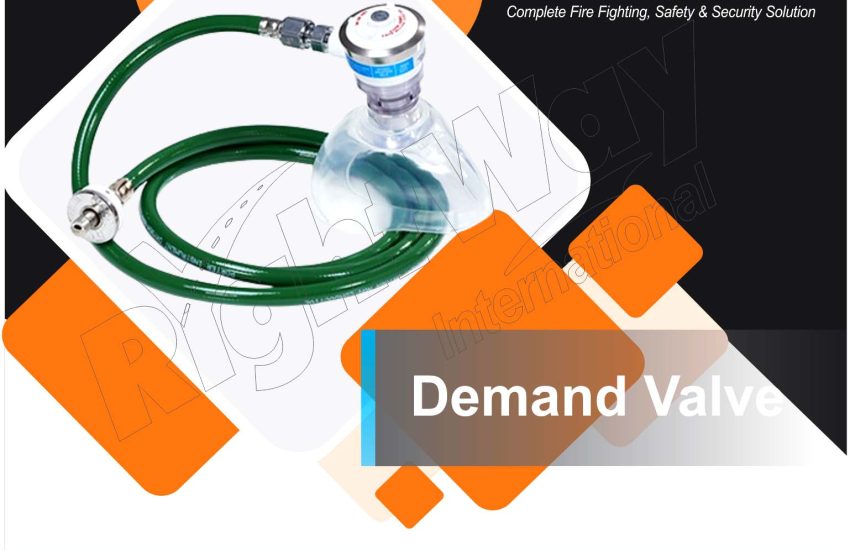demand valve plays a vital role in many respiratory protection systems, such as SCBA (Self-Contained Breathing Apparatus) and airline breathing apparatus. It controls the flow of air or oxygen to the user based on their breathing pattern, ensuring both efficiency and safety in environments with respiratory hazards.
1. Purpose and Function
The core function of a demand valve is to deliver breathable air only when the user inhales. This “on-demand” system conserves the air supply, extending the usable time of the apparatus. As a result, demand valves are especially valuable in settings where air consumption varies and precise control is critical, such as during firefighting, rescue operations, or industrial maintenance.
2. Key Components of a Demand Valve
A well-designed demand valve includes several essential components, each contributing to its reliability and responsiveness:
Valve Body
This is the outer casing that houses the internal mechanisms. It must withstand high-pressure air flow and harsh conditions, including heat and impact.
Diaphragm
A flexible membrane that detects the user’s inhalation effort. When the user breathes in, the diaphragm moves, opening the valve to allow airflow.
Pressure Regulator
This feature keeps the output pressure constant, ensuring a steady and safe air delivery rate, regardless of variations in the tank pressure.
Air Flow Adjustment Mechanism
Some models offer manual or automatic air flow control, allowing users to tailor the airflow rate to suit different breathing rates or physical demands.
Exhalation Valve
Often integrated into the assembly, this component vents exhaled air, preventing carbon dioxide buildup and maintaining comfort.
3. Types of Demand Valves
Demand valves are available in several variations to meet specific operational requirements:
Single-Demand Valves
These activate only during inhalation, closing off during exhalation. They are commonly found in SCBA systems, where air conservation is essential.
Dual-Demand Valves
These provide airflow during both inhalation and exhalation, ensuring smoother and more continuous breathing—ideal for high-stress or thermally challenging environments.
Adjustable Demand Valves
These models include manual settings for customizing airflow rates, offering versatility for different user preferences or task intensities.
4. Common Applications
Demand valves serve in various high-risk and technical fields where controlled breathing is crucial:
- Industrial Safety: Protecting workers in chemical plants, confined spaces, and toxic environments.
- Firefighting: Supplying reliable air flow while minimizing oxygen waste in smoke-filled conditions.
- Emergency Services: Supporting search and rescue operations in hazardous atmospheres.
- Diving: Supplying divers with surface-fed air that adjusts to changes in breathing pressure.
5. Maintenance and Care
Proper maintenance is vital to the demand valve’s performance and longevity. Here are key steps:
- Regular Inspections: Frequently check for wear, leaks, or mechanical damage. Ensure diaphragms and connectors are intact.
- Thorough Cleaning: Use manufacturer-approved cleaning methods to remove contaminants without compromising sensitive parts.
- Operational Testing: Periodically test the valve’s response to simulated breathing to confirm airflow responsiveness and pressure regulation.
- Timely Replacement: Replace damaged or worn components before they impact safety or functionality.
6. Safety Considerations
Ensuring proper usage and maintenance directly impacts the safety and effectiveness of the demand valve:
- Fit and Seal: Ensure that the valve connects securely to the respirator or mask, forming a complete and airtight system.
- Correct Usage: Always follow manufacturer protocols and training to operate the valve effectively.
- Air Supply Monitoring: Keep an eye on cylinder or supply pressure to avoid unexpected depletion during use.
7. Regulatory Compliance
Demand valves must comply with international safety and performance standards to ensure reliable protection:
- OSHA (Occupational Safety and Health Administration)
- NIOSH (National Institute for Occupational Safety and Health)
- CEN (European Committee for Standardization)
- CGA (Compressed Gas Association)
Complying with these standards ensures that demand valves meet stringent design, durability, and performance criteria.
Conclusion
The demand valve is more than a mechanical component—it is a lifeline in respiratory protection systems. By delivering air only as needed, it maximizes efficiency while preserving life-saving air supplies. Understanding its construction, operational types, and maintenance practices ensures that users stay protected in the most demanding environments. With proper training, routine care, and adherence to standards, demand valves continue to perform as trusted allies in occupational and emergency respiratory safety.


